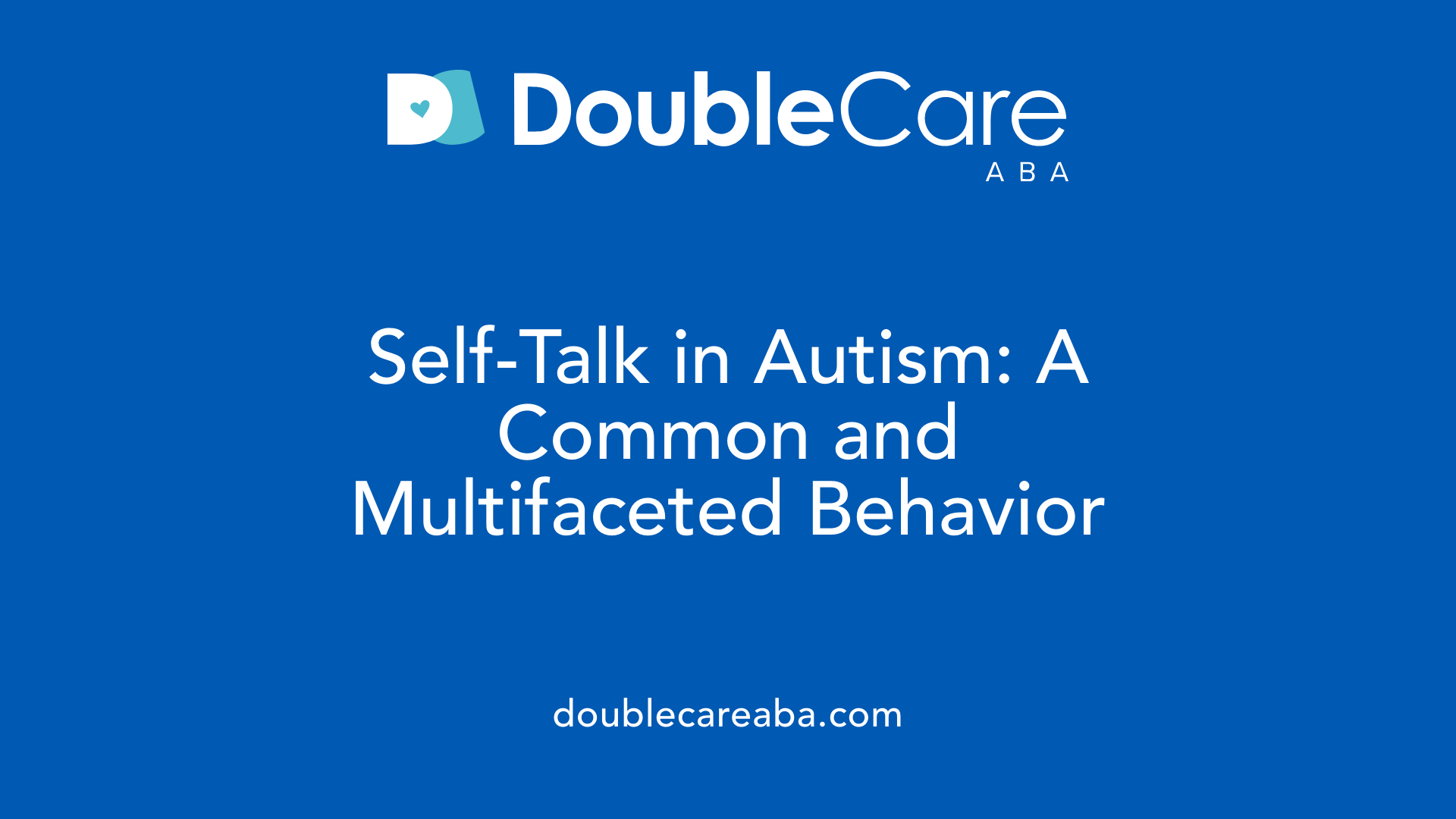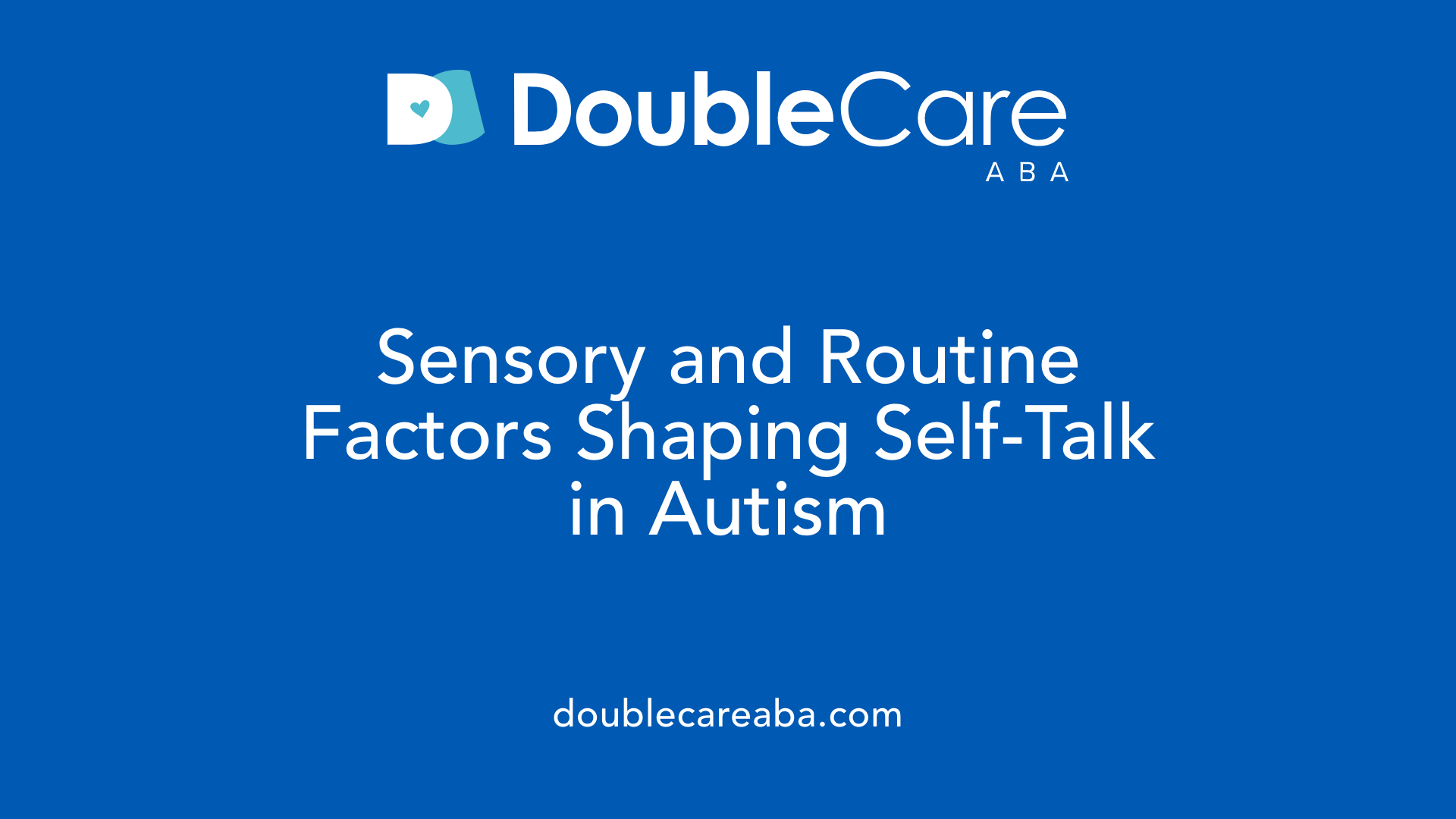Do Autistic People Talk To Themselves?
Understanding the Inner Voice of Autistic Individuals

Exploring Self-Talk and Its Significance in Autism
Self-talk is a common behavior observed among many autistic individuals, serving various functions related to emotional regulation, understanding, and navigating social and sensory experiences. This article delves into whether autistic people talk to themselves, why they do so, and how this behavior fits within their broader communication styles and mental health perceptions.
Prevalence of Self-Talk in Autism

Do autistic people often talk to themselves?
Autistic individuals frequently engage in self-talk, which plays a significant role in how they manage their daily experiences. This behavior can be both audible and internal, serving various emotional and cognitive functions.
Self-talk can involve repeating words or phrases, engaging in echolalia (echoing speech they have heard), or using scripted language. It helps many autistic people organize their thoughts, rehearse social interactions, or regulate their emotions. During times of stress, overstimulation, or transition, talking to oneself can be especially comforting and grounding.
The frequency of self-talk varies widely among individuals but remains a common behavior within the autism spectrum. For some, it is a subtle internal process, while others may speak aloud, especially if they find it helpful for focus or self-regulation.
Different forms of self-talk (audible/internal)
Self-talk manifests in multiple forms, depending on the individual’s needs and preferences. Audible self-talk often includes:
- Repeating words or phrases, especially related to specific interests or routines
- Using scripts or rehearsed dialogues
- Vocalizing emotions or thoughts to process feelings
Internal self-talk involves silent, mental conversations that aid in organizing thoughts or problem-solving. Both forms serve as valuable tools for understanding and navigating complex social or sensory situations.
Behavioral functions of talking to oneself
Talking to oneself serves several important functions for autistic individuals. It can be a way to achieve emotional regulation, provide comfort, and enhance focus. For instance, repeating a phrase can calm anxiety or help transition from one activity to another.
It also supports cognitive processing, helping individuals remember important information or plan upcoming events. Additionally, self-talk can be a form of self-advocacy, where speaking aloud emphasizes personal needs or boundaries.
Overall, self-talk is a normal part of many autistic people's lives, offering a supportive mechanism to cope with challenges, make sense of their environment, and foster their well-being.
| Aspect | Description | Example |
|---|---|---|
| Frequency | Varies from occasional to frequent | Repeating a routine phrase for reassurance |
| Form | Audible or internal | Talking aloud during a stressful moment |
| Function | Emotional regulation, organization, social rehearsal | Using scripted phrases to prepare for a social interaction |
Understanding and respecting the role of self-talk in autism can promote better support strategies and reduce misconceptions about this behavior.
Why Do Autistic People Talk to Themselves?
What are the reasons why autistic people may talk to themselves?
Autistic individuals often talk to themselves for many reasons that are natural and serve specific functions. One primary reason is self-regulation. Self-talk helps manage emotions, reduce anxiety, and provide comfort. For example, repeating words or phrases can help a person calm down when feeling nervous or upset.
Processing thoughts is another common purpose. Talking aloud can make complex ideas clearer or help organize thinking. Some autistic people use self-talk to cope with boredom or fill silence, especially during times when social interaction feels overwhelming.
Self-talk acts as a form of self-soothing. When experiencing difficult feelings such as anger or nervousness, speaking to oneself can be reassuring. It also provides a sense of control and safety in uncertain situations.
In addition, for those with limited verbal skills or who engage in repetitive behaviors—called stimming—self-talk may be part of these behaviors. It can help provide sensory input or keep their mind focused.
Overstimulation or understimulation can also trigger self-talk. When senses become overwhelmed by loud noises, bright lights, or strong smells, talking to oneself might serve to block out the excess sensory input. Conversely, in under-stimulating environments, self-talk can provide needed stimulation.
Sometimes, rapid or pressured speech, a form of self-talk, may indicate underlying mental health conditions such as anxiety, bipolar disorder, or psychosis. These situations may require professional attention to support the individual's well-being.
Recognizing these reasons helps in understanding autistic behaviors and provides ways to support them better. Whether it's for comfort, communication, or sensory management, self-talk is a valuable tool for many on the spectrum.
Self-Talk as a Key Element of Communication in Autism

How does self-talk relate to communication styles in autism?
Self-talk plays a significant role in how many autistic individuals communicate and process their environment. It often serves multiple functions, such as helping with self-regulation, understanding social cues, and managing overwhelming sensory input. Many autistic people use self-talk to rehearse conversations, express their feelings, or clarify their thoughts, especially when they find verbal exchanges challenging.
Autistic communication is frequently different from typical, neuro-typical interactions. Instead of relying on inconsequential small talk or abstract language, autistic individuals may prefer direct and meaningful exchanges. Self-talk aligns with this preference by providing a structured way to express oneself. It can include repeating words, phrases, or sounds—like echolalia—or using scripts learned from previous experiences.
Repetitive speech, echolalia, and scripted phrases are common forms of self-talk that serve as tools for understanding, comfort, and expression. For example, some individuals may repeat certain phrases during stressful moments to self-soothe or make sense of their feelings. Others might rehearse social scenarios through self-talk to prepare for upcoming interactions.
This form of communication offers insights into their internal worlds, especially when verbal interactions with others are difficult. While self-talk may seem unusual to outsiders, it is a natural and adaptive way for many autistic people to navigate daily life. It supports their ability to process social information and emotional experiences, facilitating a sense of control and understanding.
Overall, self-talk is more than just repetitive speech—it is a dynamic and meaningful aspect of how many autistic individuals communicate, cope, and connect with their surroundings. Recognizing its importance allows for a greater appreciation of their unique modes of interaction and supports more inclusive and effective communication strategies.
| Aspect of Self-Talk | Function | Typical Examples |
|---|---|---|
| Self-regulation | Helps manage emotional and sensory overload | Repeating calming words or sounds |
| Social rehearsal | Prepares for interactions or understanding social cues | Practicing scripted dialogues |
| Emotional expression | Communicates feelings when speech is limited | Vocalized thoughts about current mood |
| Internal processing | Clarifies thoughts or sensory experiences | Repeating phrases or sounds to organize thinking |
Understanding and supporting self-talk enhances communication for autistic individuals. It recognizes their unique needs and affirms their right to expressive and meaningful interaction.
The Impact of Self-Talk on Mental Health and Perception

How is self-talk related to mental health or perception in autistic individuals?
Self-talk refers to the internal dialogue that many autistic people engage in, which influences how they perceive the world and manage their emotions. For autistic individuals, this inner voice plays a vital role in emotional regulation, helping to organize their thoughts, regulate stress, and cope with sensory overload.
Autistic people often use self-talk as a coping tool to make sense of their experiences and manage overwhelming feelings. For example, they might reassure themselves during sensory sensitivities or calming themselves down when feeling anxious. This form of self-talk can be instrumental in supporting their mental health by reducing feelings of stress and helping them navigate daily challenges.
However, not all self-talk is beneficial. Negative or self-critical patterns are common and can contribute to increased anxiety or depression. Autistic individuals may experience repetitive, harmful self-evaluations that reinforce feelings of inadequacy or social fear.
Research indicates that the nature of self-talk—whether positive or negative—directly impacts mental health and perception. Positive self-talk can bolster resilience and confidence, while negative self-talk may deepen emotional struggles and distort perception of oneself and others.
Given the diverse experiences of autistic individuals, personalized approaches to fostering constructive self-dialogue are crucial. Techniques that encourage positive reinforcement, self-compassion, and mindfulness can significantly improve emotional well-being.
In summary, self-talk in autism is a double-edged sword: it can serve as a powerful support tool or, if negative, exacerbate mental health challenges. Addressing these patterns through tailored interventions can help improve perception and mental resilience, promoting a more positive outlook.
Sensory and Routine Influences on Self-Talk Behavior

How does sensory processing influence self-talk in autism?
Autistic individuals often face sensory processing difficulties, which means they are more sensitive to their environment. Bright lights, loud sounds, and strong smells can become overwhelming or distracting. In response, many use self-talk as a self-regulation tool.
This repetitive or scripted speech helps block out uncomfortable stimuli, creating a sense of control and comfort. For instance, repeating phrases or engaging in routine speech acts as a buffer against sensory overload.
Role of routines and repetitive actions in fostering self-talk
Routines and repetitive movements are common in autism. These behaviors often serve as a foundation for self-talk, providing predictability that makes interactions and internal dialogue safer and easier to manage.
By following familiar routines, autistic individuals may develop and use self-talk to navigate their day, reinforce understanding, or soothe themselves through predictable patterns.
Impact of environmental stimuli on self-talk frequency and content
The environment greatly influences how often and what type of self-talk occurs. Noisy, bright, or unpredictable settings tend to increase self-talk as a way to cope.
The content of self-talk also reflects the individual's interests or immediate needs, often focusing on topics that interest them or routines they find comforting.
| Factor | Effect on Self-Talk | Example | Importance |
|---|---|---|---|
| Sensory Sensitivities | Increase frequency | Repeating calming phrases during loud events | Helps regulate sensory input |
| Routine Complexity | Enhances predictability | Following a specific sequence of words or actions | Creates a safe coping mechanism |
| Environmental Noise | Triggers self-talk | Repeating phrases in noisy environments | Masks or manages overwhelming stimuli |
Understanding these influences underscores the importance of sensory-friendly and structured environments. Such spaces can help autistic individuals feel more secure, reducing stress and promoting healthier communication patterns.
Autism Spectrum and Variability in Self-Talk
Does self-talk vary across the autism spectrum?
Yes, self-talk can look quite different among autistic individuals, depending on their level of verbal ability and other sensory or social factors. For many with limited speech, self-talk often appears as structured, minimal, and specific. They might use their own name combined with simple action words to describe or explain what they are doing, such as saying "Okuhle eat" instead of full sentences like "I am hungry." This pattern reflects their challenges with forming complex sentences but allows them to express themselves in a way that’s manageable.
In contrast, autistic people with higher verbal skills often engage in more elaborate self-dialogue. They might think aloud, rehearse conversations, or internally process social situations, using spontaneous or complex language. Their self-talk can serve as a way to organize thoughts, cope with sensory overload, or plan their actions.
Despite these differences, self-talk is a valuable support across the spectrum. It helps individuals regulate emotions, clarify thoughts, or maintain focus, tailored to each person’s unique needs and abilities. Recognizing this spectrum of self-speech emphasizes the importance of understanding, rather than judging, each individual’s communication style.
| Level of Verbal Ability | Typical Self-Talk Characteristics | Purpose and Use |
|---|---|---|
| Limited or no speech | Brief, structured phrases using own name and actions | Explaining actions, self-regulation |
| Moderate to high speech | Elaborate, spontaneous, internal reasoning, rehearsals | Planning, processing, emotional regulation |
Understanding this variability fosters better support and reduces stigma, as all forms of self-talk are valid expressions of an autistic person’s inner experiences and coping strategies.
Supporting Autistic Self-Communication Through Self-Talk
How can support strategies promote self-talk among autistic individuals?
Supporting autistic individuals in their self-communication involves creating environments that acknowledge and reinforce their natural self-talk behaviors. Self-talk, often a way for autistic people to process thoughts, soothe themselves, or clarify ideas, can be encouraged through thoughtful strategies.
One effective approach is using communication aids, such as visual supports, picture cards, or Augmentative and Alternative Communication (AAC) devices. These tools can help make self-talk more structured and purposeful, allowing individuals to express themselves more clearly and confidently.
Establishing predictable routines and routines also fosters opportunities for self-expression. Routines provide a sense of safety and familiarity, encouraging autistic individuals to engage in self-dialogue freely.
Caregivers and educators play a vital role by modeling calm and clear language. They should avoid idioms, slang, or complex metaphors that could be confusing, instead opting for straightforward, literal language.
Providing choices and empowering individuals to make decisions can motivate them to verbalize their thoughts and preferences, further supporting self-talk.
Creating safe, judgment-free spaces is crucial. When autistic individuals feel comfortable expressing themselves without fear of criticism, they are more likely to develop and trust their self-dialogue.
Overall, these strategies help transform self-talk from a coping mechanism into a meaningful communication tool. Enhancing self-awareness and emotional regulation, supportive environments foster autonomy and confidence in autistic people’s ability to articulate their inner experiences.
The Double Empathy Problem and Its Relevance to Self-Talk

How does the double empathy problem relate to self-talk in autism?
The 'double empathy problem' suggests that communication difficulties between autistic and non-autistic people are mutual, stemming from different ways of experiencing and interpreting social cues. This idea emphasizes that misunderstandings are not solely on the autistic person's side but are a two-way street rooted in contrasting social and cognitive styles.
For autistic individuals, self-talk plays a significant role in navigating social interactions. It often functions as a method to process thoughts, rehearse conversations, or manage sensory overload and emotional reactions. Since understanding non-autistic communication norms can be challenging, self-talk becomes a way to internalize social content or soothe oneself.
This understanding helps us see self-talk not as mere repetition or eccentric behavior but as a meaningful coping strategy. It reflects an internal effort to bridge the communication gap created by differing mental frameworks.
Recognizing the mutual nature of communication differences reinforces the importance of respecting and valuing diverse ways of expression. Embracing self-talk as an authentic form of communication can foster more inclusive and understanding interactions. It shifts the perspective from viewing autistic communication as deficient to appreciating it as a different approach that deserves recognition and support.
Overall, the double empathy problem highlights that fostering better understanding requires acknowledging these reciprocal differences. Supporting behaviors like self-talk contributes to respectful, accommodating environments where autistic individuals can express their true selves without feeling misunderstood or marginalized.
Embracing the Inner Voice: A Key to Autism Understanding
Self-talk is not merely a quirky behavior but a significant aspect of how many autistic individuals process their world, regulate emotions, and communicate. Recognizing its functions and variations helps foster empathy and support tailored strategies that respect their unique preferences. Embracing the inner voice of autistic people enhances our understanding of autism as a spectrum of rich and diverse ways of perceiving and interacting with the world.
References
- Interacting with Autistic People
- Signs and Symptoms of High Functioning Autism
- Autism Spectrum Disorder (ASD) Symptoms & Causes
- Psychosis and autism
- Autism and communication
- WHY PEOPLE WITH AUTISM REFER THEMSELVES IN THE ...
- Why autism and small talk are polar opposites - Autism Matters
- Why do some autistic people seem self-absorbed?
- Autism and Communication: One Word Speaks Volumes
- Do Autistic People Talk To Themselves?
















